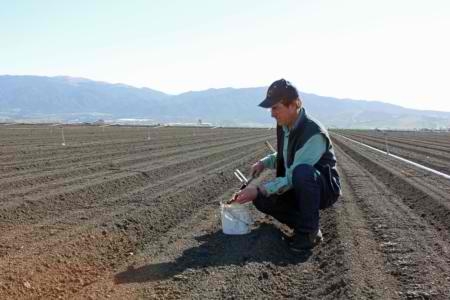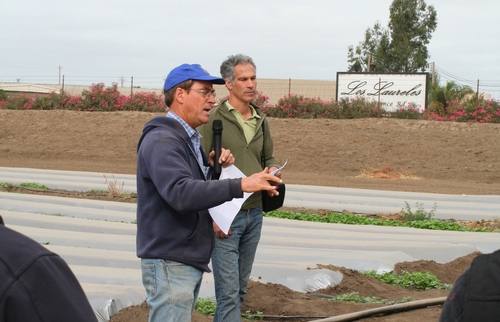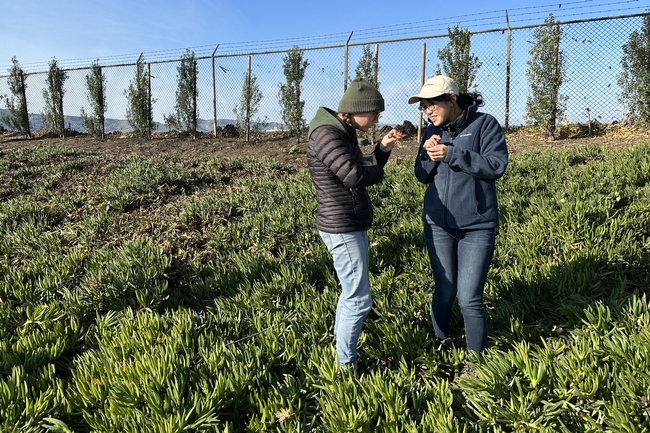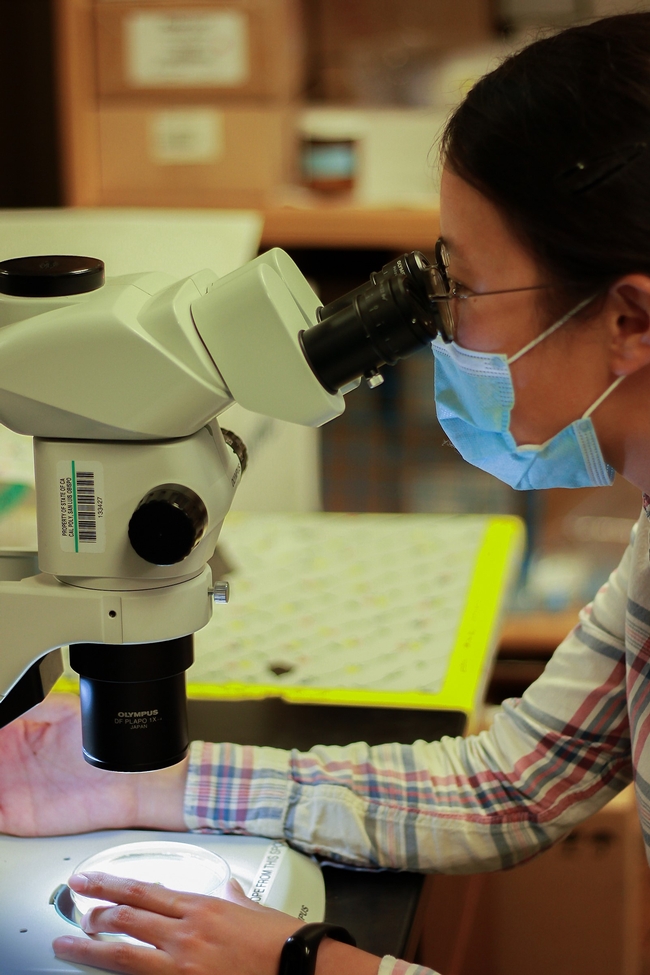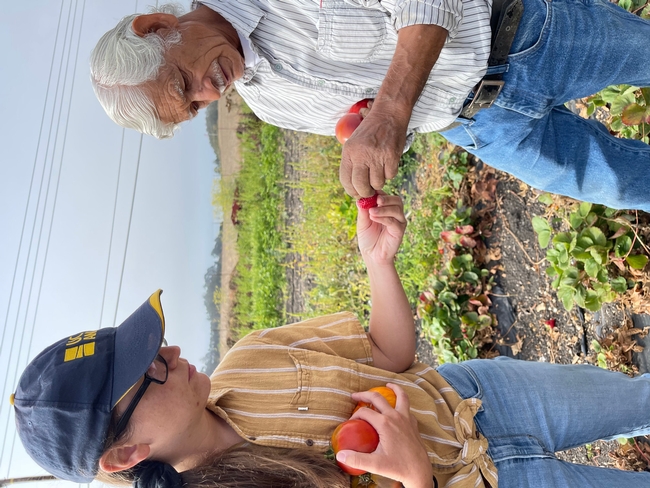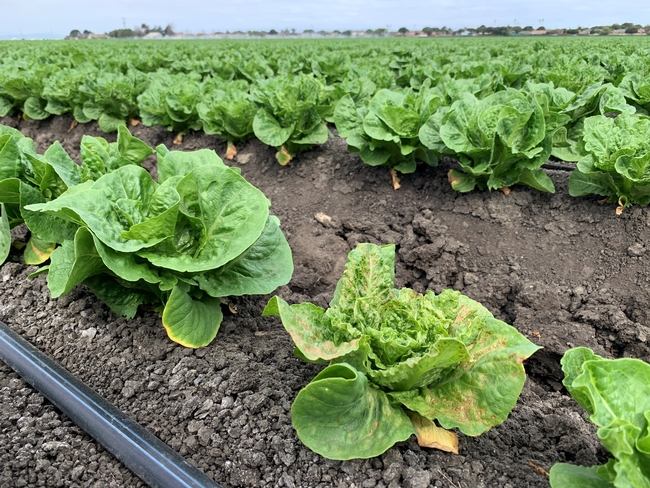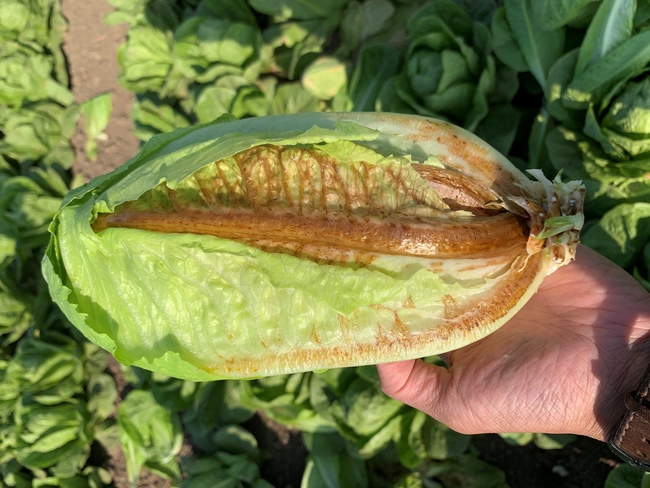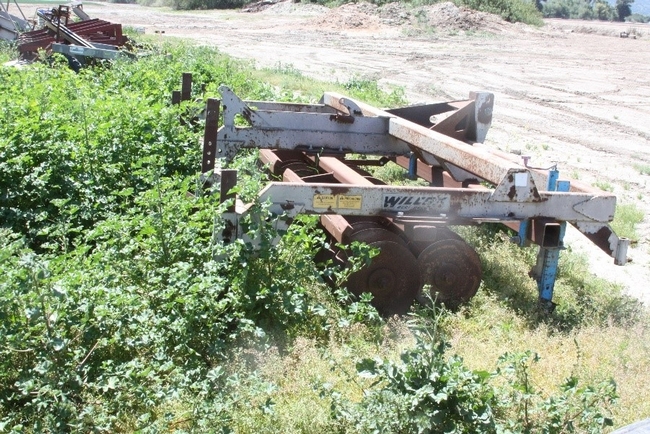
Posts Tagged: Richard Smith
Richard Smith retires after 37 years of translating science into solutions for vegetable growers
For four decades, when a new plant disease infects fields of lettuce or a new regulation is issued for agriculture, vegetable farmers across the state have turned to Richard Smith, the University of California Cooperative Extension vegetable crops advisor, for answers. After 37 years of service with UCCE, Smith retired on Jan. 4.
“The whole industry has been dreading Richard's retirement!” exclaimed Jennifer Clarke, executive director of the California Leafy Greens Research Program. “Richard is a wealth of knowledge and has a great ability to translate science into real-world practical solutions.”
In the past few years, the leafy greens industry has lost millions of dollars of crops due to infections of impatiens necrotic spot virus (INSV) and Pythium wilt. Smith is among the researchers investigating the diseases.
“Richard has conducted important variety trials and led efforts in identifying the ‘top 10' weed hosts for INSV and strategies to reduce the wintertime ‘green bridge' for this virus,” Clarke said.
Smith also has kept policymakers informed of the latest research. In 2021, he testified before the Assembly Committee on Agriculture about leafy green plant diseases.
A legacy of practical advice, service to community
By serving on numerous grower and county committees and working directly with growers, Smith has built a reputation for understanding growers' needs and developing practical solutions. He has found it rewarding to see his research results used.
“The research that I have conducted with my collaborators has helped the water board to better fit their regulations to the reality of farming and to minimize the economic constraints,” Smith said.
Smith and his colleague Michael Cahn, UCCE irrigation and water resources advisor, also have become trusted and respected voices when discussing AgOrder 4.0 with the Central Coast Regional Water Quality Control Board, according to Clarke. AgOrder 4.0 calls for farmers to reduce the amount of fertilizer they apply to crops.
Field trials conducted by Smith and Cahn showed growers they could use nitrogen from high nitrate wells toward meeting a crop's nutritional needs.
“Richard has also done important research to develop nitrogen removal coefficients for AgOrder 4.0,” Clarke said. “Recently he and Eric Brennan of USDA-ARS (Agricultural Research Service) looked at cover crops and identified a system to predict shoot biomass and allow for nitrogen scavenging credits. His work has been pivotal in helping growers comply with AgOrder 4.0 in a cost-effective and realistic manner.”
Growers also use his research to manage cadmium, a heavy metal that is naturally present in soils.
“He led the effort to help growers find a best management practice that reduces cadmium uptake in various crops,” Clarke said. “The Central Coast has areas of productive agricultural land where there are naturally occurring shale deposits. The ability to amend soil to reduce plant uptake of this heavy metal has allowed these important production areas to continue to farm nutritious vegetables.”
‘Never had a bad day as a farm advisor'
Growing up in Watsonville, Smith began working at a young age in agriculture for summer jobs.
“I was in 4-H and got to know ag advisors and was always impressed by them,” Smith said. “I was fortunate to be able to work as an advisor for my career. I never had a bad day as a farm advisor – it was very satisfying working with growers and helping them with their issues.”
Smith joined UC Cooperative Extension as a farm advisor intern in San Diego County and San Joaquin County in 1985 after earning his master's degree in agronomy from UC Davis. In 1986, he moved to the Central Valley to serve as an interim farm advisor for San Joaquin County, then became a vegetable crops farm advisor for Stanislaus County in 1987.
In 1989, Smith moved to the Central Coast to serve as UCCE small farms advisor for San Benito, Monterey and Santa Cruz counties. In 1999, he transitioned to UCCE vegetable crops and weed science farm advisor for those three counties, where he served for the rest of his career.
Mentoring the next generation of scientists
“Richard was my mentor, principal investigator on my first collaborative study at ANR, speaker at several of my extension events, and a dear colleague,” said Surendra Dara, former UCCE entomology and biologicals advisor and now director of Oregon State University's North Willamette Research & Extension Center and professor of horticulture. “He is very kind, friendly, and most importantly has a good sense of humor. He is well-regarded both by his peers and stakeholders.”
Smith has been active in professional organizations, regularly attending the annual meetings of the American Society for Horticulture Science and the American Society of Agronomy. He served as president of the California Chapter of the American Society of Agronomy in 2014 and served on the board of the California Weed Science Society, which granted him the Award of Excellence in 2005 and an honorary membership in 2020.
As a public service, Smith served on the board of the Agriculture and Land-Based Training Association, and taught classes and conducted outreach to their Spanish-speaking clientele. He was a regular guest speaker for vegetable crop and weed science classes at CSU Fresno, CSU Monterey Bay, Cal Poly San Luis Obispo, Hartnell Community College and Cabrillo Community College.
As he winds down his career, Smith has been mentoring new UCCE farm advisors and scientists who have joined USDA-Agricultural Research Service in Salinas and California State University, Monterey Bay, acquainting them with local issues.
“Richard's leadership and mentorship has been critical in the development of my career as a new researcher at USDA-ARS in Salinas,” said Daniel K. Hasegawa, research entomologist in USDA-ARS's Crop Improvement and Protection Research Unit. “Richard has taught me so much about agricultural practices in the Salinas Valley and has connected me with growers and pest control advisers, which has enhanced the impact of my own research, which includes projects addressing thrips and INSV.”
Smith, who has been granted emeritus status by UC Agriculture and Natural Resources, plans to complete nitrogen research projects that are underway.
Richard Smith retires after 37 years of translating science into solutions for vegetable growers
For four decades, when a new plant disease infects fields of lettuce or a new regulation is...
New UCCE advisors bring fresh ideas to protect lettuce from INSV, Pythium wilt
Salinas Valley lettuce growers lost about $150 million in 2022 due to diseases
A stormy winter could portend another devastating year for the lettuce industry in the Salinas Valley, which saw approximately $150 million in lost gross revenue in 2022 due to INSV (impatiens necrotic spot virus) and associated diseases. Recent drenching rains might mean more weeds – overwintering “reservoirs” for the tiny insect, the Western flower thrips, that carries INSV.
Or the extreme precipitation could benefit growers, as thrips in the soil – during their intermediate stage of development – might be drowned in the waterlogged fields.
As with so many aspects of the INSV crisis, the ultimate effects of flooded fields on thrips populations remain unknown.

“We don't know if thrips are just so persistent and so stable in that pupal stage that maybe they will emerge unaffected,” said Kirsten Pearsons, University of California Cooperative Extension integrated pest management farm advisor for Santa Cruz, Monterey and San Benito counties. “There's just so much about their biology and ecology in the Salinas Valley that we just don't know.”
The mystery of thrips, INSV and soilborne diseases (namely Pythium wilt) is why UC Agriculture and Natural Resources assigned Pearsons to the area last November and hired Yu-Chen Wang in October as UCCE plant pathology advisor for the three counties.
“They're stepping in at a critical moment,” said Richard Smith, the region's UCCE vegetable crop production and weed science advisor who retired in January after a 37-year career. “They've gotten grants funded already – and that's just incredible. They're hitting the ground running.”
Experienced in disease diagnosis and collaboration with growers and industry partners, Wang said her pathology background – paired with Pearsons' entomology expertise – will be crucial in addressing INSV and other diseases.
“It is important for Kirsten and me to work together and provide different insights for the vector and the pathogen, respectively,” Wang said.
‘It's going to take everything to get a crop'
One priority is untangling the dynamics of INSV and Pythium wilt co-occurrence – the subject of ongoing research by JP Dundore-Arias, a plant pathologist at California State University, Monterey Bay. While the vegetables may tolerate one disease or the other, their one-two punch often deals the lethal blow.
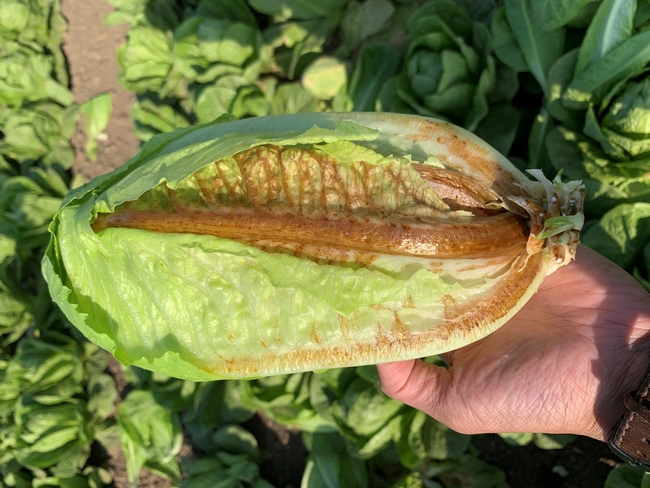
“The challenge is – which is why it's great to have Yu-Chen and Kirsten – is that we have so many problems now, whether it's Fusarium (wilt), or Verticillium (wilt), or Pythium, or INSV,” said Mark Mason, pest control adviser for Nature's Reward, which primarily grows lettuces on 5,000 acres across the Salinas Valley.
Mason said that co-infections on his crops (sometimes with three or four diagnosed diseases) make it difficult to assign monetary damages to a specific pathogen, but he noted he has seen fields with “100% loss.” According to the Grower-Shipper Association of Central California, about 11,500 acres were deemed not harvestable in 2022, representing 12% of lettuce industry acreage.
Given the gravity and complexity of the disease dilemma, Pearsons said she has been fielding calls from growers seeking new and better solutions – ways to improve existing tools, techniques borrowed from other crop systems, and additional biological or chemical means of control.
And although there are a couple of pesticides that manage the disease-carrying thrips reasonably well, growers and researchers are worried about their diminishing efficacy due to overuse. Plus, they only constitute a short-term fix.
“Managing the thrips will only reduce the amount of INSV that can get transmitted,” Pearsons explained. “You can kill 99.9% of the thrips, but you get one thrips that has INSV that enters a field, and now you have an infected lettuce plant. All of the thrips are going to come and they can spread it from there; pesticide slows things down, but it's not going to eliminate it.”
Finding disease-tolerant lettuce cultivars is a more sustainable approach. Trials conducted last year by Smith, Wang and others identified several varieties that appeared to hold up well to Pythium and INSV. While additional research could maximize their potential benefit, Wang said even the hardier cultivars will lose their resistance over time, and a multi-layered INSV strategy with “integrated management tools” is crucial.
“We realized, when this thing started happening, that we cannot spray our way out of this problem,” Mason said. “We need varieties; we need management practices; we need pesticides…it just seems like it's going to take everything to get a crop.”
Weeds key to disease control
An all-hands-on-deck approach helped control thrips-harboring weeds last winter. With fields drying out from January storms, Smith said communities must get back to weed management – with a focus on prominent weed hosts for INSV and neglected areas adjacent to farms. Hotspots of infection last year were traced to industrial lots that were overlooked during the weeding process.
“People can't lose sight of the fact that we still need to be controlling the weeds in key areas, because that's the reservoir of the virus during the winter,” Smith said. “We have to stay on task with that.”
Yet despite the diligent weed abatement, crop damage from INSV and Pythium was widespread in 2022, and Smith said it's “very possible” that high heat during the summer was a contributing factor to especially prevalent disease in fall. Thrips populations tend to thrive in warmer weather, Smith said, but much more research needs to be done to understand the basic biology of the insect, including how they acquire the virus and how they spread it.
High hopes for future
Pearsons cited the work of Daniel Hasegawa, a research entomologist with the U.S. Department of Agriculture, who leads teams in monitoring thrips populations in several locations across the Salinas Valley. Currently the counting of thrips on sticky card traps is done manually, but Pearsons and Mason mentioned the possibility of using AI and machine learning to expedite that process.
Mason said that the grower community is excited about the new technologies and ideas that Pearsons and Wang are bringing to the region. As a participant in the search for candidates to fill the advisor positions, Mason said “they were, in my opinion, by far the best fit for what we were looking for.”
“I hope they stay here for 30 years,” he added.
The new advisors both noted the palpable energy and cooperative spirit in the Salinas Valley to proactively meet the challenge.
“Looking to the past, there have been other outbreaks and diseases that they've managed to overcome,” Pearsons said. “These farmers are resilient and creative and I fully believe that lettuce will still be growing here for years to come – it might look a little different, and it might take a little bit of a painful period to get to that point, but I think that we're going to be able to come up with some solutions.”
And while there are concerns that some lettuce growers might decide to leave the region, Wang said she also believes in the industry's strong roots and rich history.
“Salinas Valley has had a beautiful climate for lettuce for so many years; there are some undeniable advantages here,” she said. “This is still the best place in the United States – and maybe the world – to grow lettuce.”
Lettuce growers hope weeding, research can counter devastating plant virus
Population explosion of insect vector contributed to $100 million in losses in 2020
While most Californians are wholeheartedly embracing the wet start to winter, one group is welcoming the rain more warily (and wearily) – lettuce growers in the Salinas Valley.
“It's a blessing, yes, we need the water,” said Tony Alameda, managing partner of Topflavor Farms, which grows a variety of produce in Monterey and San Benito counties. “But, oh gosh: with that water, here come the weeds, here comes the habitat, here comes all the other problems that go along with it.”
Weeds are overwintering havens for a tiny insect called the Western flower thrips, which in turn carries the impatiens necrotic spot virus (INSV) – a plant virus that caused $100 million in lost gross revenue for Salinas Valley growers in 2020.
The agricultural community called it “the biggest problem we've seen in a long, long time,” said Mary Zischke, facilitator of a task force convened by the Grower-Shipper Association to address INSV and a related affliction, Pythium wilt.
Widespread crop failure in 2020
Since INSV was first observed in the state in 2006, the virus – which poses no threat to people – triggered significant crop losses in 2019, leading up to a catastrophic 2020. As Alameda's lettuces began to show the telltale “bronzing” of the leaves, efforts to bag up or remove the infected plants had no effect on the virus' implacable spread.
“Nothing seemed to work,” he recalled, “and you just watch those fields collapse, week after week, until you're just like, ‘Ugh, there's nothing here to even harvest.'”
After “100% crop failure” that year in his prime fields at the heart of the Salinas Valley, Alameda tried to dodge the virus in 2021 – shifting lettuce plantings to San Benito County and instead using his most valuable land for unaffected crops such as cilantro, leeks and radishes. By decamping to San Benito, Alameda was able to harvest 70% of his usual lettuce yield.
Generally, growers enjoyed a reprieve from virus pressures in 2021. Even in this “good” year, however, about one-third of all lettuce plantings in the Salinas Valley had at least a low level of infection, according to Zischke.
“Since we were attributing a lot of our so-called good fortune – on having less damage this year – to the cooler weather, we know we can't count on that to get us out of this problem,” Zischke said. “All the models point to the fact that we're in a warming climate, so we were fortunate this year.”
More research needed on thrips
Heat waves were a major driver of the INSV disaster of 2020. Although researchers have established a link between warmer temperatures and population increases of thrips, science still has a lot to learn about those disease vectors.
“Thrips are something we're trying to understand as much as we can, but it's pretty tough because they're a little mysterious in the way they get around and where they overwinter,” said Richard Smith, a University of California Cooperative Extension vegetable crops and weed science farm advisor for the Central Coast region.
Smith – along with U.S. Department of Agriculture research entomologist Daniel Hasegawa and California State University-Monterey Bay plant pathologist JP Dundore-Arias – provided an INSV update during an Assembly agriculture committee hearing in December.
Recent studies have identified several weeds as key “reservoirs” of thrips, including malva, marestail, and hairy fleabane. The ubiquitous mustards, fortunately, appear to be poor hosts for thrips, although their pollen serve as potential food sources.
Controlling those weeds – which are beginning to spring up as the days lengthen – is a top priority during the winter months, according to Smith. Aggressive weed management in the preceding winter was an important factor in limiting the virus' spread in 2021.
And because weeds recognize no boundaries, experts are also urging managers of non-agricultural lands to keep their properties as clean as possible, including industrial sites, equipment yards and the edges of roadways – namely U.S. Route 101, which runs through the center of the valley. Some growers have been volunteering to weed their neighbors' vineyards.
“We're encouraging everybody – as best they can – to knock down known weed hosts; that's really critical,” Zischke said.
Search for long-term solutions
Within the grower community, there is “nervous optimism” for the coming year, said Alameda, as he continues to hope for an innovation that would aid in the fight against INSV – whether a more targeted pesticide application or a beneficial insect that could deter the thrips.
However, both Alameda and Zischke pointed to the breeding of more resistant lettuce varieties as the ultimate solution to INSV – albeit one that is years away.
“We have a lot of different types of lettuce that we grow, so to move resistance into all the different types of lettuce we grow throughout the season … that's going to take time,” Zischke explained.
Research funding from the state and USDA – as well as projects supported by the California Leafy Greens Research Program – can help expedite that process. But, for Alameda, the INSV crisis underscores the need for more resources and farm advisors such as Smith, who has spent more than three decades cultivating relationships and building trust within Salinas Valley communities.
Alameda would like to see a renewed focus on bringing “bright, young, passionate people who live and breathe this stuff” to the region, so growers are better equipped to handle the inevitable next calamity.
“Hopefully this is a wakeup call to all,” he said. “This is a valued industry – you have to take care of it; it cannot be taken for granted. The ‘salad bowl of the world' cannot rest on its laurels.”
ANR in the news May 16-31, 2020
ASEV's Invasive Pest Webinar Series Starts June 3
(Wine Business) May 30
… The invasive pest webinar series will include:
June 3: Impact of the New Invasive Pest, Spotted Lanternfly, in the Northeastern Vineyards by Heather Leach (The Pennsylvania State University, University Park) at noon – 1:00 p.m. (PDT)
July 2: Fruit Flies and Their Role in Causing Sour Rot by Megan Hall (University of Missouri, Columbia) at noon –1:00 p.m. (PDT)
October 22: Lifecycle Modeling and the Impacts of Climate Change by Gwen-Alyn Hoheisel (Washington State University, Prosser) at noon – 1 p.m. (PDT)
November 12: Invasive Species Response: Lessons from the European Grapevine Moth Collaboration Program by Monica Cooper (University of California, Cooperative Extension, Napa County) at noon – 1 p.m. (PDT)
https://www.winebusiness.com/news/?go=getArticle&dataId=231500
UC Davis sponsoring COVID-19 symposium
(Woodland Daily Democrat) May 30
… Statewide Extension apiculturist Elina Lastro Niño, based in the UCD Department of Entomology and Nematology, is scheduled to share her expertise on bee venom, one of the possible COVID-19 treatments suggested by researchers but not yet investigated.
… Among those asking questions will be Jennifer Cash, the newest faculty member of the UCD College of Biological Sciences; Fred Gould, a National Academy of Sciences member; UC Cooperative Extension adviser Surendra Dara; and University of Brasilia graduate student Raquel Silva.
https://www.dailydemocrat.com/2020/05/30/uc-davis-sponsoring-covid-19-symposium/
Gardens Have Pulled America Out of Some of Its Darkest Times. We Need Another Revival.
(Mother Jones) Tom Philpott, May 29
The first great national gardening mobilization came two decades later, scholar Rose Hayden-Smith writes in her 2014 book Sowing the Seeds of Victory: American Gardening Programs of World War 1. Building on a Progressive Era push to install gardens in public school yards as an educational tool, President Woodrow Wilson tapped the Bureau of Education, with funding from the War Department, to launch the US School Garden Army shortly after sending troops to intervene in the European conflict. “A Garden for Every Child,” its slogan promised. “Every Child in a Garden.”
The School Garden Army was just one of several national programs that “encouraged Americans to express their patriotism by producing and conserving food,” Hayden-Smith adds. Wilson also promoted a civic gardening boom through the Committee on Public Information, which hired writers, artists, scholars, and advertising professionals to create marketing campaigns to promote school, home, and community gardening.
More scientists joining UC Cooperative Extension
(Daily Democrat) Jim Smith, May 29
Four staff research associates will join the ranks of UC Cooperative Extension scientists in the coming months to support nut crop advisors conducting critical research in walnut, almond and pistachio production.
The California Walnut Board, the Almond Board of California and the California Pistachio Research Board together have provided about $425,000 to cover annual salaries, benefits, travel and equipment for the new UC Cooperative Extension staff. Under the terms of the agreement, the new positions will be funded annually for up to three years, pending available funds and success of the program.
Tree Nut Industry Provides Funding for more UCCE Researchers
(Ag Net West) May 29
The California tree nut industry is helping to provide funding for four new research associates who will become part of the UC Cooperative Extension system. The addition of the new personnel is being made possible by the California Walnut Board, the Almond Board of California, and the California Pistachio Research Board who have contributed a total of $425,000 in funding support. Collaborations like this are one of the many ways that the UC system is able to support important agricultural research through alternative funding methods.
http://agnetwest.com/tree-nut-industry-provides-funding-for-more-ucce-researchers/
Modoc County continues to see zero coronavirus cases
(Action NewsNow) Ana Marie Torrea, May 28, 2020
…Next month, the Modoc Junior Livestock Auction is planned for June 8 to June 12. Action News Now reached out to the U.C. Cooperative Extension which oversees the auction. A representative tells Action News Now that they've already made significant changes to the event.
The event's Facebook page says it is working to follow state guidelines by increasing seating and sanitation.
Gardens Have Pulled America Out of Some of Its Darkest Times. We Need Another Revival.
(Mother Jones) Tom Philpott, May 29
…The first great national gardening mobilization came two decades later, scholar Rose Hayden-Smith writes in her 2014 book Sowing the Seeds of Victory: American Gardening Programs of World War 1. Building on a Progressive Era push to install gardens in public school yards as an educational tool, President Woodrow Wilson tapped the Bureau of Education, with funding from the War Department, to launch the US School Garden Army shortly after sending troops to intervene in the European conflict. “A Garden for Every Child,” its slogan promised. “Every Child in a Garden.”
Women Taking the Reins at Marin's Family Farms
(Marin Magazine) Christina Mueller, May 27
…The two sisters, who grew up on the family ranch but no longer live there (Melissa lives in Novato, Jessica lives in Bend, Oregon), were looking to re-establish their connection to the family's West Marin land. After attending a University of California Cooperative Extension (UCCE) and MALT agricultural summit 15 years ago that focused on helping the next generation of Marin ranchers figure out how to sustain small family farms, the sisters started researching, digging into their family history to learn what Angelo and subsequent generations of Poncias produced. Cattle, dairy and potatoes kept appearing at the top of the list. With the help of the Tomales Regional History Center, they found an old Petaluma Argus Courier newspaper advertisement where their grandfather posted about the potato varietals he was working with. One of those varietals was known as the Bodega Red.
https://www.marinmagazine.com/women-taking-the-reins-at-marins-family-farms/
San Joaquin County cherries withstand ‘spotty' rain losses
(Ag Alert) Kevin Hecteman, May 27
… Rain gauges around the area showed 0.19 to 0.52 inch fell during this year's May storms, according to Mohamed Nouri, a University of California Cooperative Extension orchard advisor in San Joaquin County, with cherries in the Escalon area being among the most affected
… Temperature plays an important role in the rate of cherry fruit cracking, Nouri said; more water is taken up when the temperature is warm following rain, causing the cherry to expand and split.
https://www.agalert.com/story/?id=14026
Table grape industry promotes viticulture research
(Farm Press) Lee Allen, May 27
…Another of the presented research subjects involved remote sensing for nutrient content detection. Ali Pourreza of the University of California Cooperative Extension was one of the presenters.
“Future agricultural and food production systems must make better use of limited resources to ensure farmers can economically produce more high-quality food while minimizing impact on the environment,” Pourreza said. “An effective nitrogen (N) management plan involves monitoring vine N status, currently accomplished by collecting plant tissue samples for lab analysis.
https://www.farmprogress.com/grapes/table-grape-industry-promotes-viticulture-research
Houston Wilson Named Presidential Director for the Clif Bar Endowed Organic Agriculture Institute
(Cal Ag Today) May 27
Houston Wilson has been named the Presidential Director for the University of California's Organic Agriculture Institute, which was established in January 2020 with a $500,000 endowment by Clif Bar and a matching $500,000 endowment from UC President Janet Napolitano.
https://californiaagtoday.com/californias-organic-agriculture-institute-names-new-director/
Nutritious Movement
(Move Your DNA) Katy Bowman, May 26
… First up, I am talking to Dr. Rose Hayden-Smith. She is an author, educator, and advocate for a sustainable food system. She is University of California emeritus. Dr. Hayden-Smith leverages the power of social technologies in her research as a historian, to tell stories, share information, start conversations, and engage with a wide range of people interested in the food system. She believes in the power of gardens to transform the world. And I first interviewed Rose in 2018 and I'll be sharing parts of that interview, where we discuss gardening, how to get started, the history of Victory Gardens, as well as garden movement tips. But I wanted first to get Rose's take on our current situation, and what she thinks about how things are changing.
https://www.nutritiousmovement.com/gardening-movement-podcast-episode-123
California Nut Industry Funds 4 New Extension Researchers
(Growing Produce) David Eddy, May 26
Four staff research associates will join the ranks of University of California Cooperative Extension scientists in the coming months to support nut crop advisors conducting critical research in walnut, almond, and pistachio production.
https://www.growingproduce.com/nuts/california-nut-industry-funds-4-new-extension-researchers/
Specialty grant to examine impact of integrating animals in crop rotations
(Farm Forum) May 24
…“Fresh produce growers and their advisors will benefit from learning about the impacts of integrating livestock grazing with winter cover crop management on soil health including soil organic matter, nutrient cycling and reduced nitrate leaching, and potential food safety risks discovered in this project to make decisions on adoption, management, and environmental benefits of WCC in annual vegetable systems,” said Alda Pires, University of California Cooperative Extension specialist and lead principle investigator in the study.
ABC30 salutes Michael Yang on Asian Pacific American Heritage Month
(ABC30) Aurora Ortiz Diaz, May 22
ABC30 salutes Michael Yang on Asian Pacific American Heritage Month.
Yang is a former Hmong refugee who came to the United States when he was ten years old. He has worked for UC Cooperative Extension's Division of Agriculture and Natural Resources for 26 years.
Yang says, "I'm a certified pesticide safety trainer, I speak Hmong, Lao, and English." Yang connects with local Southeast Asian farmers when he visits their farms in the central valley. "Fresno is a nice place to grow everything. We're the number one ag county in the nation."
Project explores livestock grazing impacts on organic crops
(Feedstuffs) May 22
…“Fresh produce growers and their advisors will benefit from learning about the impacts of integrating livestock grazing with winter cover crop management on soil health, including soil organic matter, nutrient cycling and reduced nitrate leaching and potential food safety risks discovered in this project to make decisions on adoption, management and environmental benefits of winter cover crop management in annual vegetable systems,” said Alda Pires, University of California Cooperative Extension specialist in the University of California-Davis (UC-Davis) School of Veterinary Medicine and principle investigator in the study.
https://www.feedstuffs.com/nutrition-health/project-explores-livestock-grazing-impacts-organic-crops
Leafy Green Growers Will Survive COVID-19
(Growing Produce) Carol Miller & Frank Giles, May 20, 2020
…“The lag in adjusting to the situation is mostly a two-month window for a crop like lettuce,” says Richard Smith. Smith is a University of California Vegetable Crop and Weed Science Farm Advisor at the Cooperative Extension in Monterey, Santa Cruz, and San Benito counties.
…“Companies varied in their level of exposure to this market that just collapsed,” Smith says. “Some were more exposed than others. Given other issues with the food distribution system, in general, some growers think that they may be 30% overplanted.”
https://www.growingproduce.com/vegetables/leafy-green-growers-will-survive-covid-19/
The Underlying Importance of Improving Broadband Expansion
(AgNet West) Brian German, May 20
The University of California Agriculture and Natural Resources (UC ANR) continues efforts to assist rural Californians in gaining access to high speed internet. UC ANR has spearheaded multiple initiatives that have driven development in underserved areas of California to provide better coverage in rural communities. Vice President of UC ANR, Glenda Humiston noted the importance of providing broadband internet to rural, agricultural communities will become even more critical moving forward.
http://agnetwest.com/the-underlying-importance-of-improving-broadband-expansion/
Hard-fought industry wins 'evaporating' under new budget reality
(Agri-Pulse) Brad Hooker, May 20
… Roschen was also disappointed by a 10% cut to the current budget for the UC Agriculture and Natural Resources Division.
Here's how to stay safe while buying groceries amid the coronavirus pandemic
(Brooklyn Reader) Erin DiCaprio, May 19
Wear a mask, but skip the gloves. Don't sanitize the apples. And if you are older than 65, it's probably best to still order your groceries online.
As a food virologist, I hear a lot of questions from people about the coronavirus risks in grocery stores and how to stay safe while shopping for food amid the pandemic. Here are answers to some of the common questions.
https://bgr.com/2020/05/19/coronavirus-food-safety-tips-grocery-shopping-wear-a-mask/
https://www.expressnews.com/news/article/Here-s-how-to-stay-safe-while-buying-groceries-15280166.php
The Conversation https://www.youtube.com/watch?v=TICHjPLwcIY https://theconversation.com/heres-how-to-stay-safe-while-buying-groceries-amid-the-coronavirus-pandemic-138683
New bioinsecticide promises help with tree nut pests
(Farm Press) Tim Hearden, May 19
….“Based on what I hear from some growers and the biopesticide industry data, there has been a steady increase in biopesticide use,” said Surendra Dara, a University of California Cooperative Extension entomologist.
https://www.farmprogress.com/crop-protection/new-bioinsecticide-promises-help-tree-nut-pests
These 5 foods show how coronavirus has disrupted supply chains
(Nat Geo) Sarah Gibbens, May 19
… “What we have is a low-cost and efficient system that allows for huge variety and attention to individual tastes,” says Daniel Sumner, an economist at the University of California, Davis.
“A dairy farm has milk coming out of the cow into a tank. That milk must be pasteurized and packaged, meeting lots of food safety standards,” says Sumner.
Individual farms generally can't afford the equipment necessary to process milk on site without raising prices significantly. “Nowhere is a dairy farm suited to send milk directly to a store,” Sumner says.

